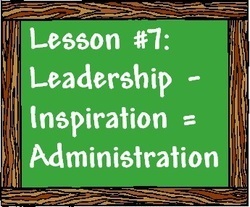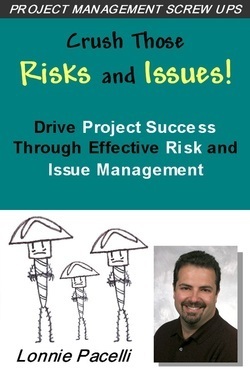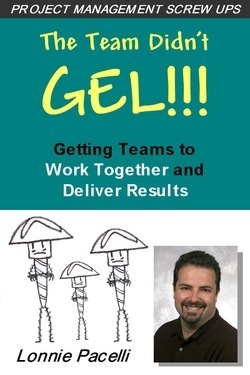Lonnie Pacelli's Blog, page 82
February 21, 2014
The Five Biggest Mistakes a Human Resources Professional Can Make…From the Client’s Perspective
 A number of years back I was in a meeting with two HR representatives at my company.They were explaining to me how the HR organization wanted to be more “strategic” with its clients and how they wanted to help us with annual resource planning. At the time, our biggest problem was filling open positions with qualified candidates; a number of key positions had been open for months with no qualified candidates in the hiring pipeline. When I asked the HR reps about how they were going to help with this problem, they both told me that they didn’t have time to address the hiring issues because they were tasked with being more “strategic”. Needless to say, the meeting went downhill in a hurry because the HR reps were more interested in fulfilling the HR organization’s “be strategic” mandate than they were in helping me with my real-life problem.
A number of years back I was in a meeting with two HR representatives at my company.They were explaining to me how the HR organization wanted to be more “strategic” with its clients and how they wanted to help us with annual resource planning. At the time, our biggest problem was filling open positions with qualified candidates; a number of key positions had been open for months with no qualified candidates in the hiring pipeline. When I asked the HR reps about how they were going to help with this problem, they both told me that they didn’t have time to address the hiring issues because they were tasked with being more “strategic”. Needless to say, the meeting went downhill in a hurry because the HR reps were more interested in fulfilling the HR organization’s “be strategic” mandate than they were in helping me with my real-life problem. As a longtime client of numerous HR organizations, I’ve learned to appreciate the value that HR professionals provide and the times my HR partner protected me from potentially difficult situations. When working well, the client, employees, and company as a whole benefit. When things don’t work so well, though, everyone ultimately loses. Through my years as a client, I’ve locked down on five of the biggest mistakes that an HR professional can make in their relationship with the client, as follows:
Amazon.com Widgets Not understanding the client’s business – Foundational to an HR professional’s success is s strong understanding of their client’s business. What are the key products the client offers? What does the client want to accomplish in the next fiscal year? Is the client’s product emerging, stable, or declining? What are the client’s key business challenges? Does the client face any significant financial issues? Have the professional self esteem to know that the client wants you to invest some time to understand their business. Being a team player means spending time with the team to better understand how your services can be best applied in the client’s organization.
Trying too hard to get the client to understand the business of HR – Many HR professionals I’ve worked with wanted to “educate” me on terminology, concepts, or the latest HR trends. While the education was interesting and helped broaden my horizons somewhat, much of the education wasn’t relevant to my job or important for me to know. If there are truly important terms and concepts that the client is going to need to know to get their job done effectively, then by all means educate away. However, if the HR-ese is not material to the client getting their job done, then skip the education session. Help the client with what is need-to-know and keep the rest in your bag of tricks. Not understanding the basics of employment law – My most valuable experiences with my HR partners were situations where my HR partner helped me to understand employment law issues and advised me on courses of action to take to minimize legal risk. When an HR professional understands the basics of employment law and can recognize situations where further legal advice may be required, potentially hundreds of hours of lost productivity are mitigated. By not having employment law basics down, the HR professional not only puts the client’s business at risk but also suffers a credibility hit in the client’s eyes. Know enough to advise the client and when additional legal help needs to be brought in. Showing bias in supporting either management or employees – A crucial credibility factor for an HR professional is demonstrating impartiality while dealing with HR issues. If an HR professional has a reputation for being biased toward management, then they get a rap for being a “company” person and potentially legitimate employee issues may never surface. Conversely, when the bias is toward the employee, then they can be accused of holding “witch hunts” against management. The best HR professionals walk this line carefully and ensure that their thought process and advice represents consideration of sound business and legal thinking. They also need to have the courage of their convictions to tell either management or an employee when and where they think they are going wrong. Don’t become a "yes man" or “yes woman” for either side. Not establishing expectations of work to be performed – Perceptions of the services an HR professional provides can be radically varied from client to client. While one client may see an HR professional as a recruiter, another may see the HR professional as an employment mediator, while a third may see him or her as an overall generalist. Establish a service-level agreement or contract with the client to ensure a common understanding of services performed, what is expected from the client, and expected timeframes in which services will be performed. Key to this is ensuring that the contract is mutually understood and agreed-upon; it’s not enough for the HR professional to quote department policy about what will or won’t be done for the client. Make it clear about what you’ll do for the client, what you expect from the client, and in what timeframe the work will be done.
An HR professional that understands the client’s business, shields the client from the HR-ese, is unbiased, delivers against clearly set expectations, and protects the company and employee fairly can be an invaluable partner to both the client and the company as a whole. Avoid these five major mistakes and you’ll build a high degree of trust and credibility with your client, be viewed as a trusted business partner, and save potentially countless hours of lost productivity and waste.
Published on February 21, 2014 14:32
Leadership - Inspiration = Administration
 Sam is a very experienced manager who just accepted a new position running a customer support call center for a medical supplies manufacturer. Sam has managed organizations ranging in size from several people to several hundred people. His style of leadership has always been one of command and control: he tended to dole out tasks to his team and micro-manage the execution of the tasks until the work was complete. Monica, the manager that Sam replaced, was recently promoted to vice president and is now Sam’s boss. Monica’s style of leadership was more about inspiring the team through direction setting, joint planning with the team, empowering the team to deliver, and coaching through the execution.
Sam is a very experienced manager who just accepted a new position running a customer support call center for a medical supplies manufacturer. Sam has managed organizations ranging in size from several people to several hundred people. His style of leadership has always been one of command and control: he tended to dole out tasks to his team and micro-manage the execution of the tasks until the work was complete. Monica, the manager that Sam replaced, was recently promoted to vice president and is now Sam’s boss. Monica’s style of leadership was more about inspiring the team through direction setting, joint planning with the team, empowering the team to deliver, and coaching through the execution. Sam had been on the job about four weeks when the defections started. Those team members who were used to Monica’s inspirational style of leadership were now subject to Sam’s command and control style. While some of the team just sucked it up and stayed in the organization, the drop in productivity was dramatic. Several of the team members approached Monica about Sam’s leadership style. Monica decided to take action.
Monica scheduled a meeting with Sam to discuss the drop in productivity and some of the reasons for the drop. Sam clearly held to a view that the productivity drop was due to the change in leadership and that things would get better as the team got more used to him. Though Monica was skeptical, she agreed to let Sam try to work things out. Two months went by; productivity was still down and the attrition rate was higher than ever. Monica approached Sam about the continued drop in productivity. Sam in so many words told Monica that he knew how to manage teams and let him do his thing. Monica had seen enough and decided to replace Sam. His inability to inspire the team and his command and control method of leadership ultimately resulted in his removal.
How could Sam have inspired his team? Find out in Why Don't They Follow Me?
Published on February 21, 2014 13:16
4 Ways to Immediately improve Your Work/Life Balance (?)
 Entrepreneur Magazine recently published an article entitled 4 Ways to Immediately Improve Your Work/Life Balance. While I'm not a fan of instant-soup methods of achieving work/life balance, the article touches upon several interesting concepts that, if the reader truly embraces them, can definitely lead to better work/life balance. I particularly like the concepts "Lower Your Expectations of Yourself" and "Schedule Dedicated Spouse Time". Keep in mind that the ideas presented truly need to be digested and transformed into habits that you practice every day. Some good advice here, just make sure you stick with it. Amazon.com Widgets
Entrepreneur Magazine recently published an article entitled 4 Ways to Immediately Improve Your Work/Life Balance. While I'm not a fan of instant-soup methods of achieving work/life balance, the article touches upon several interesting concepts that, if the reader truly embraces them, can definitely lead to better work/life balance. I particularly like the concepts "Lower Your Expectations of Yourself" and "Schedule Dedicated Spouse Time". Keep in mind that the ideas presented truly need to be digested and transformed into habits that you practice every day. Some good advice here, just make sure you stick with it. Amazon.com Widgets
Published on February 21, 2014 13:16
Microsoft and Cloud Computing
 This week Microsoft named its Cloud Computing chief Satya Nadella as it's next CEO. Nadella is only the 3rd CEO in the company's nearly 40-year history after Bill Gates and Steve Ballmer. Nadella is a great choice. He's very tech savvy, forward thinking, and well respected. I've had a very long-standing relationship with Microsoft as an employee and consultant and am very pleased with the Board's choice. Read a bit more on some of Nadella's priorities as CEO.
This week Microsoft named its Cloud Computing chief Satya Nadella as it's next CEO. Nadella is only the 3rd CEO in the company's nearly 40-year history after Bill Gates and Steve Ballmer. Nadella is a great choice. He's very tech savvy, forward thinking, and well respected. I've had a very long-standing relationship with Microsoft as an employee and consultant and am very pleased with the Board's choice. Read a bit more on some of Nadella's priorities as CEO.
Published on February 21, 2014 13:16
Cloud Storage Vs. Hard Drive
 I'm getting more and more into cloud storage for personal files. My wife and I use skydrive for business files we share. We encounter an occasional glitch or two, but on balance it's much nicer having files available on any device and to selectively share with others. The Standard helps contrast the good, bad and ugly about cloud storage in this elementary-level cloud storage article. If you're a cloud neophyte this might be helpful to help you decide on whether or not to have your head in the clouds...
I'm getting more and more into cloud storage for personal files. My wife and I use skydrive for business files we share. We encounter an occasional glitch or two, but on balance it's much nicer having files available on any device and to selectively share with others. The Standard helps contrast the good, bad and ugly about cloud storage in this elementary-level cloud storage article. If you're a cloud neophyte this might be helpful to help you decide on whether or not to have your head in the clouds...
Published on February 21, 2014 13:15
Our Fallibility as Leaders
 Some time back I was reminded about a crucial attribute that all seasoned leaders possess. What surprised me was that it didn't come from what I do in my work life, it came from an interaction I had with my then 15-year-old son.
Some time back I was reminded about a crucial attribute that all seasoned leaders possess. What surprised me was that it didn't come from what I do in my work life, it came from an interaction I had with my then 15-year-old son. Sparing you some of the gory details, we had a situation where my son and I had to have some "man talk" where I expressed some displeasure with his behavior. It wasn't pretty and was very uncomfortable for him and not at all pleasant for me. Given that I took some huge withdrawals from the emotional bank account with him I recognized that I needed to have a more grounded follow-up discussion with him the next day.
After he came home from school the next day he and I had a good little chat about how to avoid interactions like we had the night before. I also told him that when I was his age I was four times as mischievous as he was and that he is a better kid than I ever was. It is a huge morale boost for him to hear that his Dad has screwed up in the past. It helps him to see that I am human, I have my faults, and that he easily can live up to my standards as set by example. I've told him things I haven't spoken of in years. It was great for both of us.
This interaction reminds me of our role as leaders. The best, most seasoned leaders I know aren't afraid to share their warts and show themselves as leaders who have learned not only from their successes but also their failures.
 Those leaders who demonstrate that they are fallible and can courageously share when they've bungled it are the leaders that garner the greatest respect from their teams. Those who are afraid to bare their souls and tell of their screw-ups don't demonstrate courage, which is vital to any leader's credibility.
Those leaders who demonstrate that they are fallible and can courageously share when they've bungled it are the leaders that garner the greatest respect from their teams. Those who are afraid to bare their souls and tell of their screw-ups don't demonstrate courage, which is vital to any leader's credibility. Use your successes and failures to help your teams learn from you and to model courage. Your teams will respect you immensely and be much more likely to follow your lead.
Published on February 21, 2014 06:41
February 15, 2014
Cloud Computing Facts and Predictions for 2014
I ran across this very cool graphic on cloud computing facts and predictions for 2014. As PM's, it's more and more important that you get versed on the cloud, the value it brings, and the challenges involved in implementing cloud-based solutions. If you're still at the lower end of the cloud learning curve, check out a few more Amazon resources to help you get better versed on the cloud. Amazon.com Widgets
Published on February 15, 2014 03:38
Crush Those Risks and Issues!
 Buy
PC
|
Kindle
|
iTunes
|
Nook
Buy
PC
|
Kindle
|
iTunes
|
Nook
Project risk and issue management is one of the most lethal but easily overlooked aspects of successful project management. Risks and issues derail your plan and cause you to divert focus away from project activities. But, there’s simply no avoiding them. If you’ve got a project you’re going to have risks and issues.
Buy PC | Kindle | iTunes | Nook
Published on February 15, 2014 03:38
February 14, 2014
Big Data Skills Pay Top Dollar
I ran across this NetworkWorld article on tech salaries. Front and center is Big Data. Nine of the top 10 highest paying IT salaries are for skills relating to Big Data. With the petabytes of structured and unstructured data out there and organizations desperate to mine it to help them better achieve their objectives, Big Data developers and scientists are going to be in high demand for the foreseeable future. If you're pondering career choices or changes, consider something in the Big Data field as an option.
Published on February 14, 2014 14:58
The Team Didn't Gel: Getting Teams to Work Together and Deliver Results
 Buy
PC
|
Kindle
|
iTunes
|
Nook
Buy
PC
|
Kindle
|
iTunes
|
Nook
When project teams work in perfect harmony it's like music to the project manager's ears. Each project team member knows what they need to contribute to the project, knows when they have to perform, understands what other project team members are doing on the project, and knows what it takes to be successful. Get this ebook see how to get your project teams to gel and deliver results.
Buy PC | Kindle | iTunes | Nook
Published on February 14, 2014 14:57



